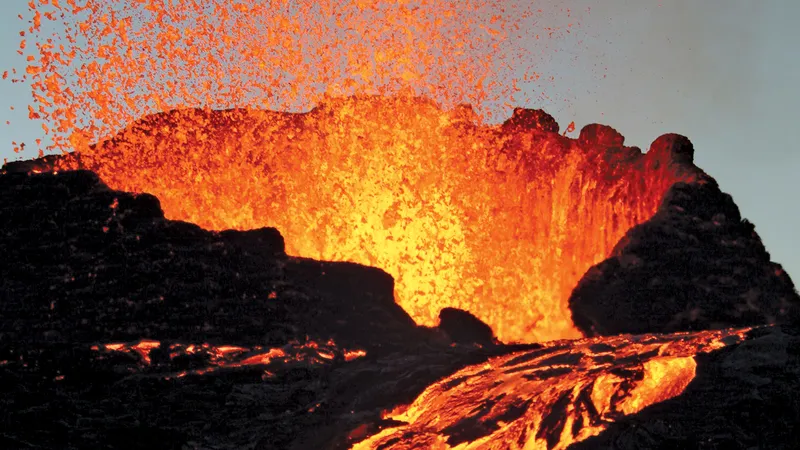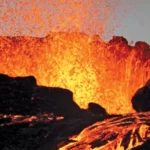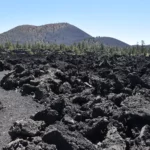Get ready for a wild ride as we uncover the secrets of Mauna Loa, the biggest active volcano on the planet. Dive deep into a world of fascinating facts, mind-blowing geological marvels, deep cultural roots, and scientific breakthroughs that make this natural giant so incredible. Hold on tight as we explore the power and beauty of Mauna Loa, a true testament to the wonders of our volcanic world.
Mauna Loa Interesting Facts
Mauna Loa, meaning “long mountain,” is anything but an ordinary volcano. This geological wonder dominates the landscape of the Island of Hawaii, claiming the title of the world’s largest active volcano. Its summit towers over 4 km above sea level, and its massive base extends over half of the Big Island, showcasing its immense scale.
What makes Mauna Loa even more intriguing is the sheer weight it exerts on the Earth’s crust. The volcano’s mass is so substantial that it causes the Pacific plate to sag beneath it, offering a glimpse into the powerful forces at play beneath the Earth’s surface.
But Mauna Loa’s story is not just about its size. The volcano has played a pivotal role in shaping the Hawaiian Islands. Its eruptions, though infrequent, have poured out lava that has solidified over millennia, contributing significantly to the Island of Hawaii’s current form.
Despite its active status, Mauna Loa’s eruptions are generally characterized by gentle slopes and slow-moving lava flows. This relatively calm nature has allowed for human habitation and scientific observation, providing valuable insights into volcanic processes.
Let’s delve a bit deeper into what makes Mauna Loa so fascinating:
- Ancient Powerhouse: Scientists estimate Mauna Loa’s age to be somewhere between 700,000 and one million years old, meaning it has witnessed a significant portion of Earth’s history.
- Weighty Matters: Mauna Loa’s immense size isn’t just impressive; it physically impacts the Earth. Its massive weight actually depresses the Earth’s crust beneath it.
- Cultural Cornerstone: For native Hawaiians, Mauna Loa is a sacred place, deeply connected to the islands’ cultural heritage and prominently featured in Hawaiian mythology.
- Living Laboratory: Mauna Loa is home to numerous scientific observatories. Its remote location and high altitude make it ideal for observing atmospheric conditions and studying volcanic activity and climate change.
Mauna Loa is a force of nature, shaping the land, impacting the environment, and reminding us of the power beneath our feet. It’s a place of beauty, power, and scientific wonder that continues to intrigue all who encounter it.
What are Some Fun Facts about Mauna Loa?
Think about this: it would likely take you at least two months just to walk around the base of Mauna Loa! That’s because its base covers a gigantic area.
- A Peek Inside: If you were to peek into Mauna Loa’s summit crater, you’d be looking into a massive bowl almost a mile wide and deeper than a football field is long.
- Rivers of Molten Rock: During Mauna Loa’s eruptions, lava flows can reach up to 10 miles, shaping the stunning landscapes of Hawaii. Places like the Waipio Valley and the Pololu Valley owe their dramatic beauty to Mauna Loa’s fiery activity.
- Earth-Shaking Power: Some experts believe that Mauna Loa’s eruptions are so powerful they may have even caused earthquakes as far away as California!
While we’ve learned a lot about Mauna Loa, ongoing research continues to uncover more about its fiery past and potential future.
What is an Interesting Story about Mauna Loa?
Mauna Loa is steeped in Hawaiian history and mythology. The ancient Hawaiians believed that Mauna Loa was the offspring of Papahānaumoku, the Earth Mother, and Wākea, the Sky Father. Legends say that Pele, the goddess of fire and volcanoes, resides within the volcano, and her fiery temperament is evident in Mauna Loa’s eruptions.
One such eruption, a stark reminder of Pele’s power, occurred in 1843 when the volcano erupted, devastating the village of Kaʻū and resulting in tragic loss of life.
Beyond its cultural significance, Mauna Loa is a scientific gold mine. Each eruption offers scientists a glimpse into the inner workings of volcanoes and Earth’s interior. The Mauna Loa Observatory, located on the volcano’s northern slope, acts as a watchdog, constantly monitoring the volcano’s every move to predict future eruptions and safeguard the island’s inhabitants.
Mauna Loa stands as a legendary giant, fueled by a fiery temper and revered as a place where myths and science converge, reminding us of the awesome power of the natural world.
What are 3 Fun Facts about Mauna Kea?
While we’ve been focusing on Mauna Loa, its neighbor, Mauna Kea, also boasts some incredible features:
- Taller than Everest (Sort Of!): Mauna Kea is actually taller than Mount Everest if you measure from its base on the ocean floor! This underwater giant stretches a whopping 10,203 meters (33,505 feet), with a significant portion hidden beneath the waves.
- Stargazer’s Paradise: The summit of Mauna Kea offers incredibly clear and dark skies, perfect for astronomical observations. Its high altitude and location in the middle of the Pacific Ocean make it home to the famous Mauna Kea Observatories, where some of the world’s most powerful telescopes reside.
- A Sacred Place: For the Native Hawaiian people, Mauna Kea is more than just a mountain; it’s a deeply sacred place, believed to be a connection to their ancestors and the realm of the gods.
Mauna Kea, in all its geological and cultural splendor, is a testament to the wonders of the natural world. To learn more about this fascinating mountain, check out these Mt. Rainier fun facts.
How Old is Mauna Loa?
Geologists estimate Mauna Loa’s age to be somewhere between 700,000 and one million years old. Over this immense period, Mauna Loa has been actively erupting and spewing lava, slowly building up its massive form layer by layer. Each eruption, whether a gentle lava flow or a more dramatic event, has added another chapter to Mauna Loa’s story and sculpted the captivating Hawaiian landscape we admire today.
Determining the exact age of geological formations like volcanoes is an intricate process. Scientists employ various techniques, such as analyzing rock formations, studying lava composition, and utilizing sophisticated dating methods to get as close to the true age as possible.
Some experts suggest that Mauna Loa might be even older than current estimates indicate. Geological clues and the possibility of undiscovered, earlier eruptions remain areas of ongoing research.
Why is Mauna Loa So Popular?
Mauna Loa’s popularity stems from a captivating blend of size, activity, scientific importance, and cultural significance:
- Mind-Boggling Size: Mauna Loa’s sheer size is a spectacle in itself. Its weight is so immense that it causes the Earth’s crust to sag beneath it, a testament to its geological impact.
- Frequent, Gentle Eruptions: Mauna Loa’s frequent but relatively non-explosive eruptions, characterized by slow-moving lava flows, have captivated observers for centuries.
- Window into Our Planet: The Mauna Loa Observatory, perched high on the volcano’s slopes, serves as a vital scientific outpost for studying volcanic gases, atmospheric changes, climate change, and more.
- Cultural Significance: Native Hawaiians revere Mauna Loa. It features prominently in their cultural fabric, considered a sacred place woven into ancient chants, stories, and beliefs.
- Enduring Mysteries: Despite all we’ve learned, Mauna Loa still holds secrets. Ongoing research aims to predict future eruptions and unravel the mysteries hidden within, ensuring a source of fascination for scientists and nature lovers alike.
What was the Deadliest Eruption of Mauna Loa?
Mauna Loa’s eruptive history is marked by a significant event in 1868. The eruption, a stark display of the volcano’s power, lasted for five days, unleashing a devastating sequence of earthquakes, landslides, and a tsunami.
The eruption resulted in the tragic loss of 77 lives, with 4,000 acres of land utterly decimated. Lava flows, some stretching over five miles, engulfed villages and reshaped the landscape.
This event serves as a somber reminder of the destructive force of nature and the importance of preparedness and respect for these powerful forces.
How Tall Will Mauna Loa Get?
Predicting the future growth of a volcano is a complex task. While Mauna Loa will likely continue to grow taller over time, the process is a delicate dance between volcanic eruptions that add to the mountain’s height and erosion from wind, rain, and ocean waves that slowly wear it down.
Scientists consider factors like the frequency and intensity of future eruptions when making predictions. Based on the behavior of shield volcanoes like Mauna Loa, which are known for their gentle slopes formed by layers of lava flows, it’s reasonable to anticipate continued growth over the coming centuries and millennia.
However, it’s important to remember that nature is unpredictable. There’s no guarantee that future eruptions will follow the same patterns as those in the past. Mauna Loa’s growth remains a dynamic process, a source of intrigue for scientists and a reminder of Earth’s ever-evolving nature.
Is Mauna Loa in the Ring of Fire?
Contrary to what some might think, Mauna Loa is not part of the Ring of Fire.
The Ring of Fire is an area in the basin of the Pacific Ocean where a large number of earthquakes and volcanic eruptions occur. It is associated with a nearly continuous series of oceanic trenches, volcanic arcs, and volcanic belts and plate movements.
Mauna Loa, however, is situated in the middle of the Pacific Plate, far from the tectonic plate boundaries that characterize the Ring of Fire. Its volcanic activity is fueled by a “hotspot,” a plume of super-heated rock rising from deep within the Earth. This hotspot is responsible for the creation of the entire Hawaiian island chain as the Pacific Plate slowly drifts over it.
Can You Live on Mauna Loa?
While Mauna Loa doesn’t boast bustling towns or cities on its slopes, a few hardy individuals do call the area home, residing in small communities and scientific research stations scattered around its base. However, living on or near Mauna Loa presents unique challenges:
- Volcanic Activity: The ever-present risk of eruptions shapes life on Mauna Loa. While scientists are adept at predicting activity, it remains a fact of life for residents.
- Remoteness: Life near Mauna Loa means embracing solitude. Resources are limited, and access to amenities requires significant travel.
- Harsh Climate: Despite Hawaii’s tropical image, Mauna Loa’s climate can be harsh, with strong winds, chilly temperatures, and heavy rainfall.
Living on Mauna Loa is an adventure suited for those who prioritize solitude, scientific exploration, and are comfortable with a degree of risk.
How Big Was Mauna Loa?
Mauna Loa’s size is staggering:
- Area: It covers a massive 5,271 square kilometers, roughly half the size of the entire island of Hawaii.
- Volume: Mauna Loa contains approximately 75,000 cubic kilometers of volcanic material—a testament to millennia of eruptions.
- Hidden Depth: A significant portion of Mauna Loa’s height is submerged. Measured from its base on the ocean floor to its summit, it towers over 30,000 feet, surpassing even Mount Everest in height.
Mauna Loa’s enormous scale serves as a powerful reminder of the forces that have shaped our planet.
For further volcanic adventures, delve into these interesting facts about Mt. Vesuvius, another fascinating volcano with a rich history.
- Senior at What Age: Benefits & Eligibility Guide - March 29, 2025
- Unlocking Senior Benefits: How Old is a Senior? Your Complete Guide - March 29, 2025
- Master Russian Politeness:A Guide to Saying Please - March 29, 2025
















